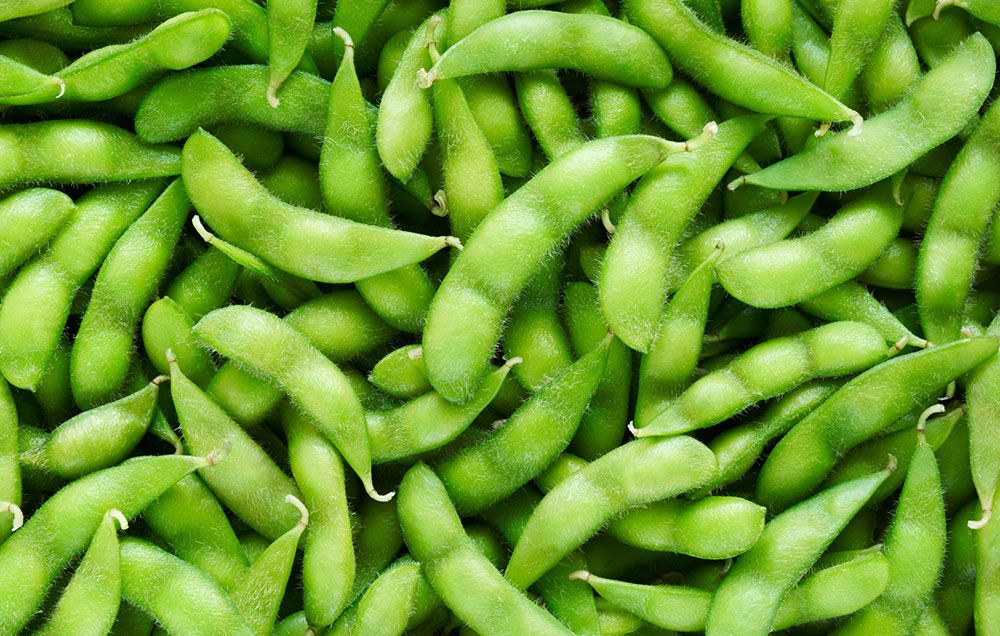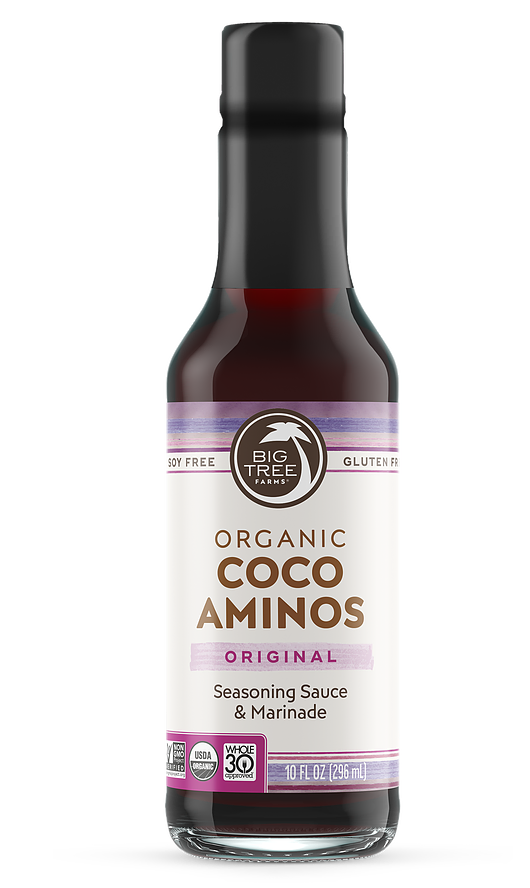
If you’ve ever done the Whole30 or stepped foot in a Trader Joe’s, you’ve heard of coconut aminos. I mean, they’re in soooo many soy-free and gluten-free recipes.
Coconut aminos’ claim to fame: They’re a legit alternative to soy sauce. And while there’s nothing wrong with keeping a bottle of traditional soy sauce in your pantry, there are a few solid reasons to cut back on the stuff.
First of all, traditional soy sauce is very high in sodium. Just one tablespoon contains 879 milligrams (about 38 percent of the recommended daily allowance), and chances are you use more than one tablespoon at a time.
Plus, traditional soy sauce also contains both soy and wheat, two of the eight most common food allergens, according to the Food and Drug Administration (FDA).
It’s no wonder health-conscious eaters are on the lookout for soy sauce alternatives that deliver on funky, savory flavor without the potential drawbacks—but coconut aminos still feel somewhat mysterious.
Here’s what to know the next time you consider picking up a bottle of this salty sauce for soy-free stir-fries and the like.
What are coconut aminos exactly?
Traditional soy sauce is made by fermenting a mixture of soybeans and roasted wheat in salt and water, and straining out the solids so that only a liquid remains.
Coconut aminos are made through a similar process. However, instead of soybeans and wheat, it’s made by mixing coconut palm sap with salt and water, according to culinary scientist Jessica Gavin.
As a result, coconut aminos are sweeter and less salty than typical extremely-salty soy sauce. However, the savory flavor is similar enough that coconut aminos can be used similarly to soy sauces in stir-fries, marinades, dipping sauces, vinaigrettes, and more, Gavin says.
Are coconut aminos healthier than soy sauce?
Remember that whole thing about soy sauce being crazy high in sodium? Here’s what you get in one tablespoon of soy sauce, per the USDA nutrient database:
- Calories: 8.5
- Fat: 0 g
- Saturated fat: 0 g
- Sodium: 879 mg
- Carbs: 0.8 g
- Fiber: 0.1 g
- Sugar: 0 g
- Protein: 1.3 g
And here’s how one tablespoon of coconut aminos (from the popular brand Coconut Secret) compares:
- Calories: 15
- Fat: 0 g
- Saturated fat: 0 g
- Sodium: 270 mg
- Carbs: 3 g
- Fiber: 0 g
- Sugar: 3 g
- Protein: 0 g
While coconut aminos are a little bit higher in naturally-occuring sugar (from the coconut sap) than soy sauce, they also contain less than one-third the amount of sodium.

For anyone on a low-sodium diet, which the American Heart Association recommends for people with high blood pressure or other heart disease risk factors, coconut aminos are certainly a better choice. Even if you don’t keep a close eye on your sodium intake, opting for coconut aminos can make it much easier to stay below the USDA Dietary Guidelines for Americans limit of 2,300 milligrams of sodium per day.
Coconut aminos are also a great choice for anyone on a gluten- or soy-free diet, says Gavin.
Do coconut aminos have health benefits?
Other than tasting great and being free of potential allergens and excess sodium, coconut aminos don’t exactly have superfood properties.
Although research shows that coconut sap itself has anti-inflammatory and antioxidant benefits, there’s no proof that coconut aminos offer the same benefits.
Since the amount of actual coconut in coconut aminos is quite low, it’s unlikely that thestuff offers the same benefits as coconut meat or sap, according to dietitian Ansley Hill, RD.
Still a great soy sauce swap, though!
Are there other soy sauce alternatives besides coconut aminos?
Great as coconut aminos may be, they’re not the only soy sauce swap option you’ve got.
Tamari, which is made through the same process minus the wheat, is a common soy sauce alternative. Though it’s naturally gluten-free (and tastes almost exactly like soy sauce), it’s typically even higher in sodium, with 1,010 milligrams per tablespoon.

Liquid aminos are another popular soy sauce substitute. Like tamari, liquid aminos are made with soybeans but no wheat, so they’re also gluten-free and similar in flavor to soy sauce. Like tamari, though, liquid aminos are incredibly high in sodium, with 960 milligrams per tablespoon.
Are there any downsides to coconut aminos?
From a health standpoint, coconut aminos are a safe way to add flavor to dishes. Keep in mind, though, that while they’re much lower in sodium than soy sauce and other alternatives, that 270 milligrams per tablespoon still adds up quickly.
The only other potential downside of coconut aminos is the cost.
Whereas a 20-ounce bottle of tamari soy sauce costs just $4.49 on Thrive Market, you’ll pay $4.99 for just eight ounces of coconut aminos. They’re a little bit cheaper at Trader Joe’s (bless!), where an 8.5-ounce bottle puts you back $2.99.
How to add coconut aminos to your eats
In addition to TJ’s and Thrive Market, you’ll also find coconut aminos at natural food stores like Whole Foods and most large grocery stores these days.
Try these three brands, recommended by Gavin:
 Coconut Secret Coconut Aminosamazon.com$7.82SHOP NOW
Coconut Secret Coconut Aminosamazon.com$7.82SHOP NOW
 Big Tree Farms Organic Coco Aminos Seasoning Sauceamazon.com$9.69SHOP NOW
Big Tree Farms Organic Coco Aminos Seasoning Sauceamazon.com$9.69SHOP NOW
 Bragg Organic Coconut Liquid Aminos All-Purpose Seasoningamazon.com$10.11SHOP NOW
Bragg Organic Coconut Liquid Aminos All-Purpose Seasoningamazon.com$10.11SHOP NOW
She loves using coconut aminos in place of soy sauce in meat marinades, alongside garlic and other aromatics in stir-fry sauces, dipping sauces, and sweet-salty vinaigrettes.
The bottom line: Whether you’re trying to cut back on sodium or just looking to mix things up a little bit, coconut aminos are gluten-, wheat-, and soy-free, and lower in sodium than soy sauce.
Source: Read Full Article